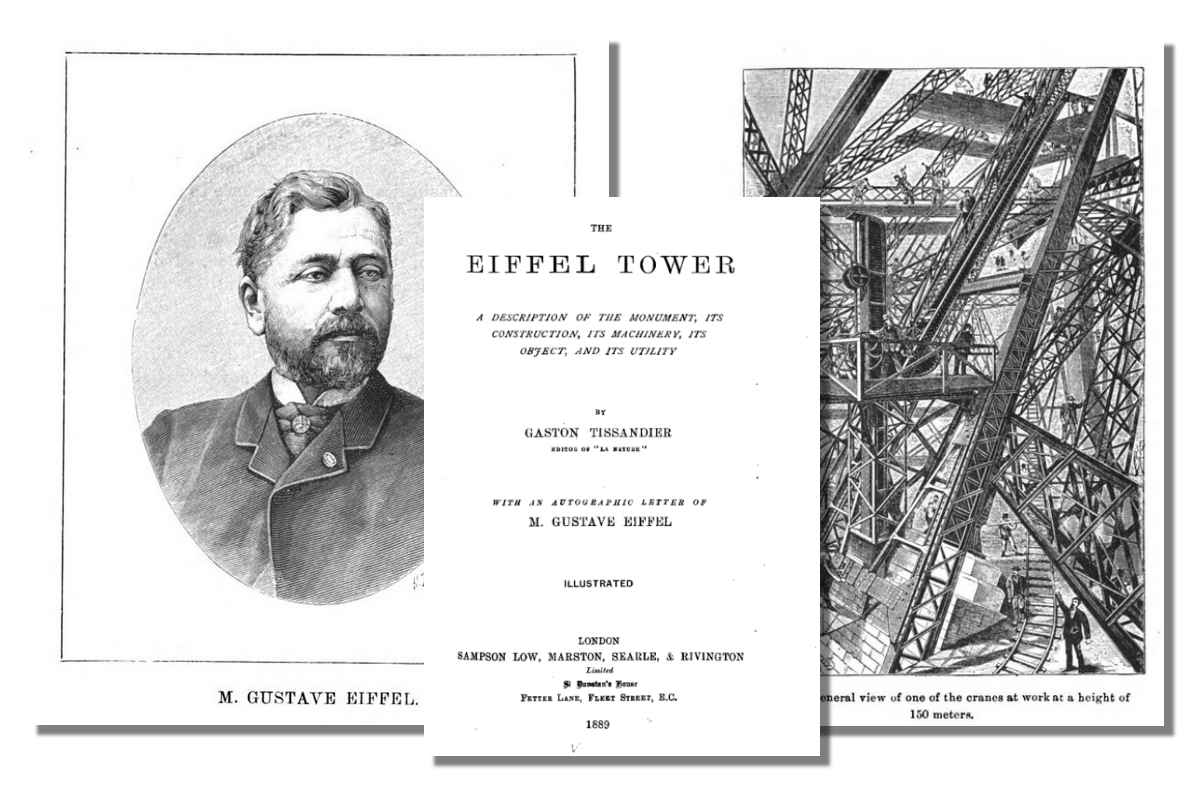
Ready to get a peek inside the Eiffel Tower? The Eiffel Tower: A Description of the Monument, Its Construction, Its Machinery, Its Object, and Its Utility by written Gaston Tissandier in the late 1880s is an illustrated look inside.
The preface adequately (and very interestingly) explains the purpose of the book:
The Eiffel Tower, that immense monument compared with which the Great Pyramid of Egypt, the Washington Obelisk, and the Cathedral of Cologne are but of moderate altitude, rises majestically at the entrance to the Champ de Mars.
The colossus of iron is worthy of its position as the triumphal porch of the Exhibition of 1889. It is the great Edifice of the close of that nineteenth century whose discoveries mark it as the greatest of all epochs during which humanity has been working out its evolution.
Half the world will come to admire the efforts which France has thought fit to make to show her vitality; and none will deny that the amount of talent displayed on the Champ de Mars for the Centenary Exhibition has been prodigious, and that all former enterprises of a like nature have been surpassed.
The Tower, 300 meters in height, is the chief attraction of this astonishing collection of marvels. It has seemed to us that the public will not be satisfied by merely visiting and admiring the colossal monument; they will wish to know how it has been designed, what methods were employed in its construction, to what uses it can be put; but eager enough as they may be to learn, they may find it difficult to be taught.
To help them in their task we offer this little book; and we shall be happy to have aided them in any way to further appreciate the magnificent structure which is so justly the object of their present interest.
Well.
The book is beautifully illustrated, and helps describe the magnitude of the project (conveyed so purposefully in the preface).
We start with the foundation: sand, clayey sand, and “earth of all kinds, not at all suited as a basis for foundations.” The process of preparing this soil to support the structure is fascinating.

Next, the ironworks began. Using scaffolding, counterweights, and sandboxes to keep the tower level, the unskilled workers overcame vertigo and fear of heights to build to the first platform.
The number of men then employed on the Tower was 250, including 20 gangs of rivetters.
The Tower had now become a very fine sight, and the immense interest it would attract when finished was clearly foreshadowed. The Parisians were in quite a state of excitement regarding the astonishing project, and every Sunday from the beginning of November, 1887, the Pont do Jena and the quay near the Champ de Mars were crowded with people watching the progress of the works. And the curiosity of the crowd increased when it was seen that now the first platform was complete, it was to be used as the floor of another workshop.
The book goes on in this fashion covering:
- The hydrophilic presses that the feet of the tower rest on.
- The campanile or tower summit.
- The lighthouse.
- The staircases and elevators.
- The uses of the tower.
The book also includes a biography of Eiffel.
The Eiffel Tower is a great way to begin a study of France. We have added this free eBook to our Eiffel Tower unit and our France unit. Oui, oui!
Free eBook
Suggestions
- Create an Eiffel Tower notebook.
- There are dozens of wonderful illustrations that can be copied or printed and pasted into a Paris, France, or Eiffel Tower notebook.
- There are four specific, along with several other speculative, uses for the tower. Numerate and describe these.
- Learn what the Eiffel Tower has been used for through history since the book was written.
- Write a biography of Gustave Eiffel.
- Draw an illustration of the Eiffel Tower (or create a 3D model).
Additional Resources

The Eiffel Tower: A Unit Study
Dozens of resources to help you with the suggestions above.
France: A Unit Study
Expand your study!










You must be logged in to post a comment.